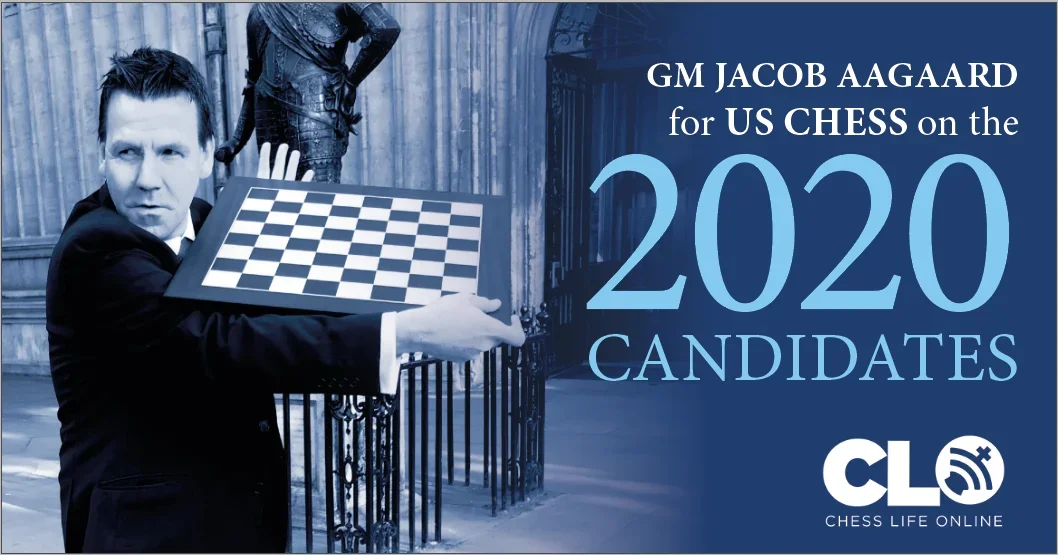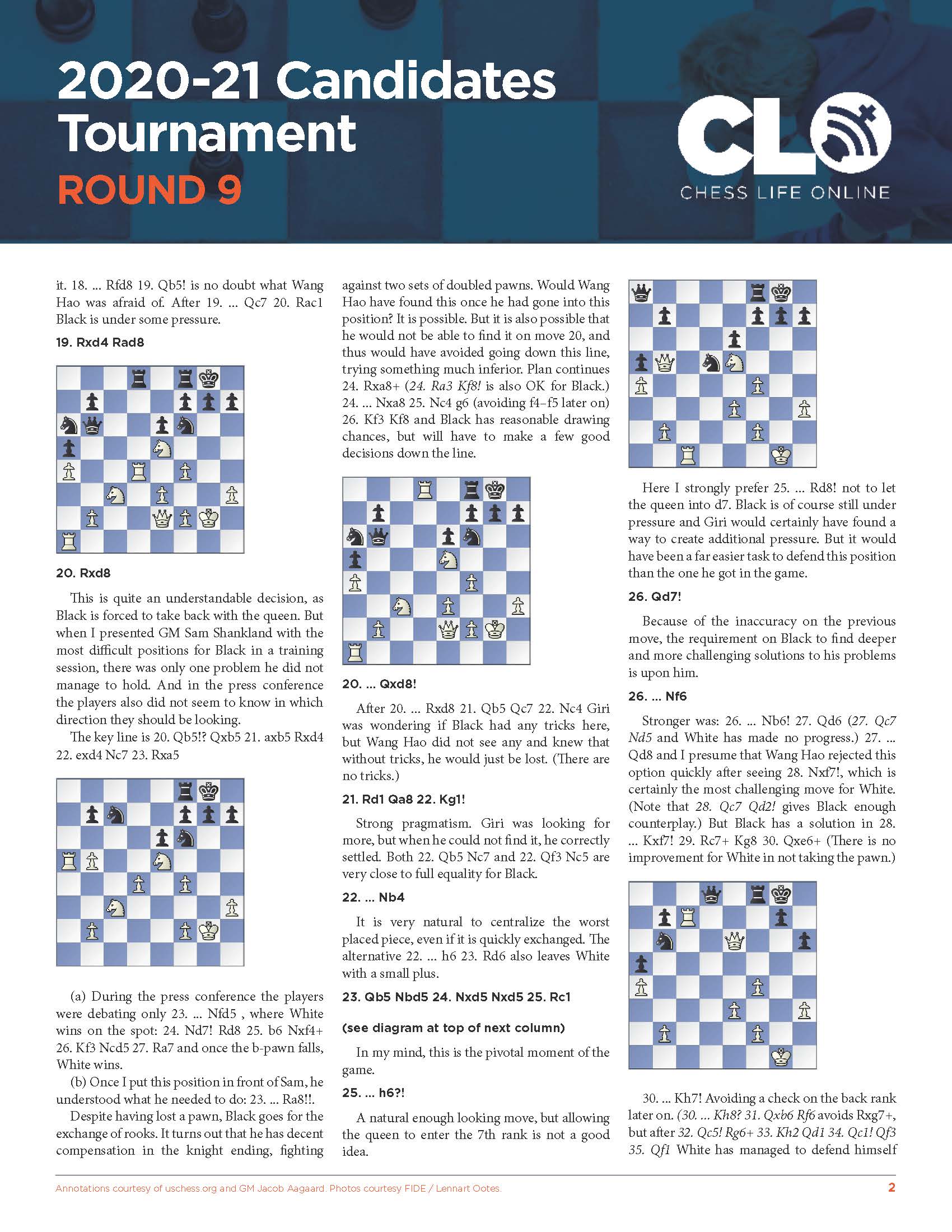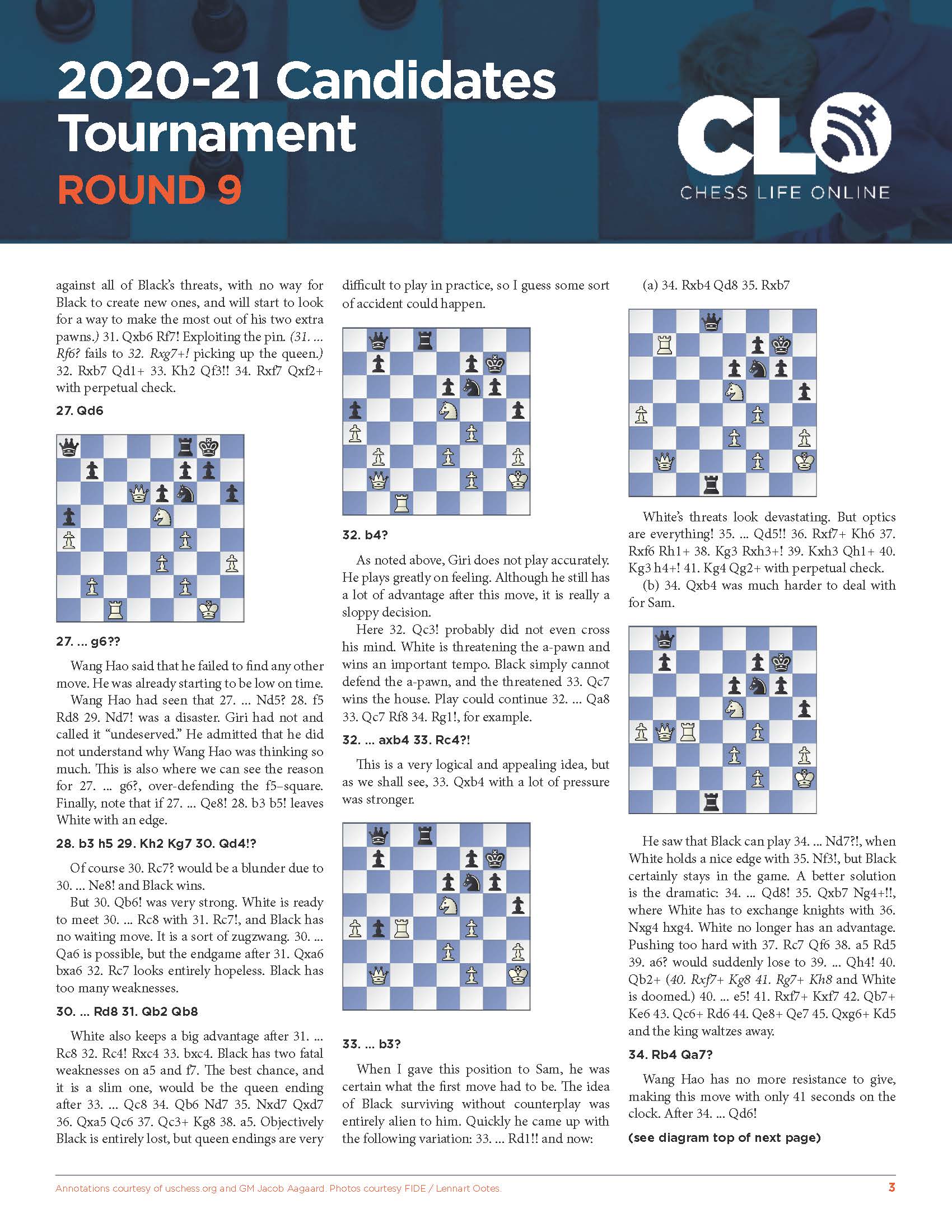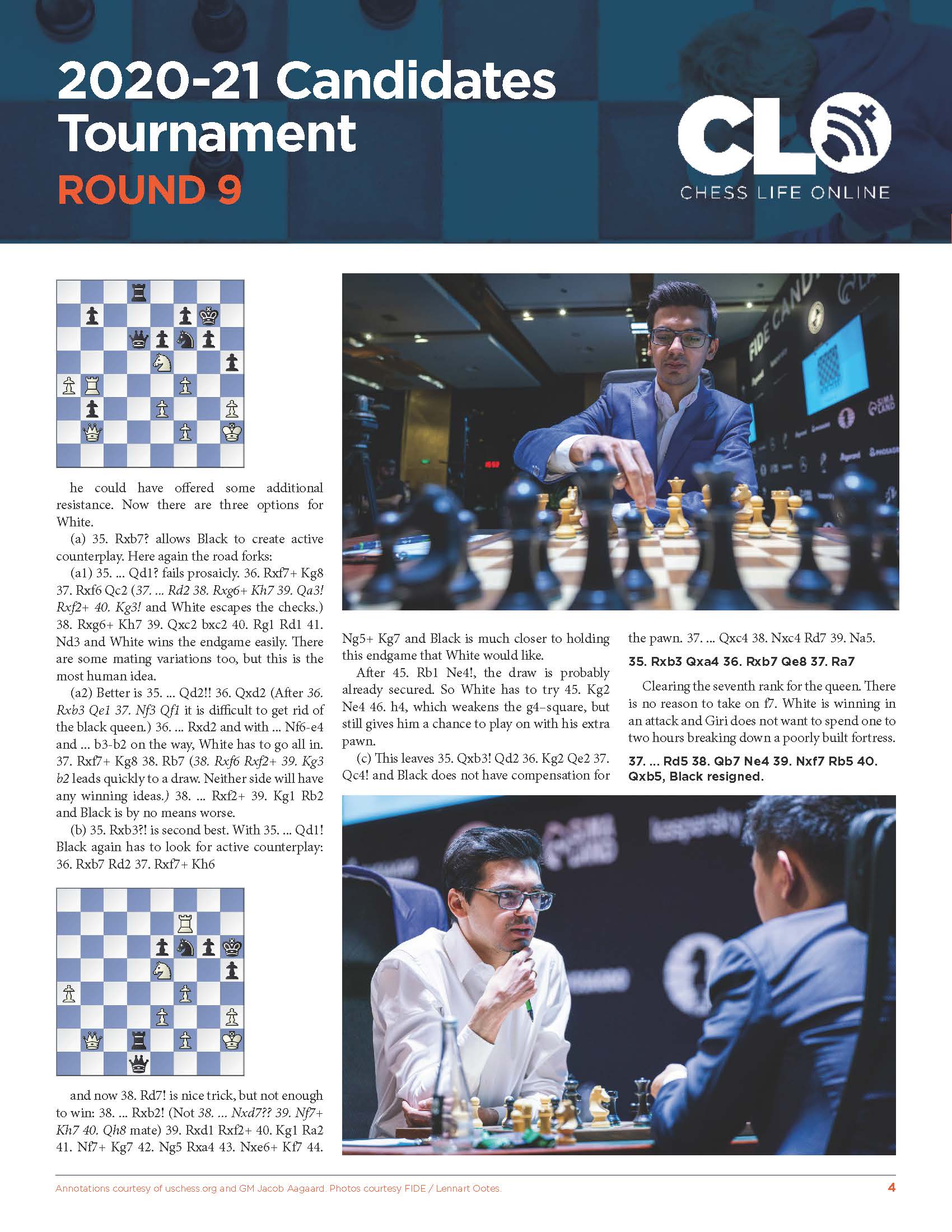For the ninth installment of his “Candidates Game of the Day” series, GM Jacob Aagaard has analyzed GM Anish Giri's impressive victory over GM Wang Hao as only he could – deeply, extensively, definitively. This is the analysis that the experts will be quoting tomorrow, and we have it exclusively here at Chess Life Online.

Fans of Aagaard's work may also want to check out his recap of Round 9 on the Killer Chess Training YouTube channel.
https://youtu.be/EDnl7UDglS4
Below we provide Aagaard’s analysis in replayable format. For those who prefer paper, boards, and pieces, we have created a pdf version.
You can also check out an alternative replayable version posted in the ChessBase Cloud.
[pgn][Event "Candidates Tournament"] [Site "Yekaterinbrug"] [Date "2021.04.20"] [Round "9.3"] [White "Giri, Anish"] [Black "Wang, Hao"] [Result "1-0"] [ECO "E05"] [WhiteElo "2776"] [BlackElo "2763"] [Annotator "GM Jacob Aagaard"] [PlyCount "79"] [EventDate "2021.??.??"] [SourceTitle "KillerChessTraining.com"] [SourceDate "2021.04.20"] [SourceVersion "1"] [SourceVersionDate "2021.04.20"] [SourceQuality "1"] [WhiteTeam "Netherlands"] [BlackTeam "China"] [WhiteTeamCountry "NED"] [BlackTeamCountry "CHN"] {The game of the Day in terms drama, was definitely Ding Liren - Vachier-Legrave. Drama often means bad moves, which was definitely the case there. You can look at the YouTube video we did here: https://youtu.be/ EDnl7UDglS4 But equally important for the standing in the tournament was the one win of the day. Giri moves into shared second and will be just as likely to sneak ahead with a win against Caruana or MVL later, as any of them will with a win against Anish. The narrative of the game is a common one for games involving Giri. He comes with a nice idea in the opening and his opponent does not react in the best possible way. This gives Giri a slight pull. It is difficult for his opponent to find the best way to defend and the advantage grows, without Giri showing special accuracy. He plays with confidence, speed and a high level of competency. He will never make a mistake in terms of evaluation or chess understanding. And his technical sensibility is great. But when it comes to several moves looking similar on the surface, he is poor at telling them apart. So, as happens so often, he misses a few accurate moves and gives his opponent a chance to create counterplay. But as we saw in the Candidates a year ago, accuracy in defence is not a particular strength for Wang Hao and he missed a number of possible ways to save the game (I gave them to Sam Shankland to solve just as the game ended to be able to make this claim) . They were spectacular, but not different from what we saw in a number of games in the first half of the tournament or what we see in top games regularly.} 1. d4 Nf6 2. c4 e6 3. Nf3 d5 4. g3 Be7 5. Bg2 O-O 6. O-O dxc4 7. Qc2 a6 8. a4 {[#] A quiet line of the Catalan, where White opts for a slight pressure and Black goes for solidity.} Bd7 {The bishop is superfluous and will be exchanged.} 9. Qxc4 Bc6 10. Bf4 Bd6 11. Nc3 Bxf4 12. gxf4 a5 $1 {Fixing the pawn structure in a useful way on the queenside.} 13. e3 Na6 ({It would be a bit premature to take on f3 here.} 13... Bxf3 14. Bxf3 c6 {and White is in time to play} 15. b4 $1 axb4 16. Qxb4 Ra7 {, as in Bonn – Zakarian, London 2019. It is not in any way a serious advantage for White, but it is a little something; and that is what people who play the Catalan are looking for. The goal is not to prove superior preparation, but to pose the opponent small problems that can accumulate and cause serious concerns long term.}) {[#]} 14. Ne5 $1 {A novelty by Grischuk's definition, of "no top player having played like this". I personally think that it is a great move. When we look at the emerging structure, it is easy to see that the light squared bishop will not be able to cause Black any problems, while the knight on e5 will not be so easy to remove and will be able to work together with the other pieces to create some long term ideas.} ({A game between two other top players went:} 14. Rac1 Nb4 15. Rfd1 Ra6 (15... Bxf3 $1 16. Bxf3 c6 {is the most solid approach in my opinion. I cannot see a valid reason why the bishop on f3 is a strong piece.}) 16. Qe2 Nbd5 17. Nb5 Ne7 18. Nd2 Bxg2 19. Kxg2 Nfd5 20. Nc4 Ng6 21. Kh1 Qe7 22. b3 Rd8 23. Rd2 Raa8 24. Rdc2 Nb4 25. Rd2 Nd5 26. Rdc2 {½-½ Ivanchuk – Dominguez Perez, Varadero 2016.}) 14... Bxg2 15. Kxg2 c6 16. h3 $1 $146 {The real novelty of the game. Not a spectacular one. The idea is simply. The king hides on h2 and in many situations, leaving the g-file to the rooks. Also, controlling the g4-square is useful in many situations with such a pawn structure, while it is hard to think of a situation where the h3-pawn is weaker than it was on h2. Facing this for the first time at the board} (16. Rfd1 Nb4 17. Qe2 Qe7 18. Rd2 Nbd5 {Korovnik – Bozyavkin, email 2020.}) {[#]} 16... Qb6 {Wang Hao reacts poorly to Giri's idea.} (16... Nb4 17. Kh2 Nbd5 18. Rg1) 17. Qe2 c5 $6 {Opening up the position is a bad idea that only helps White. Black is not ready for it. On top of this Wang Hao spent 21 moves doing this.} (17... Nb4 18. Rg1 Nbd5 {was solid. Black waits. Can White create real threats after} 19. Kh2 {, or not? You can presume that Giri had ideas ready, but objectively, Black should be absolutely fine.}) 18. Rfd1 ({Engines will tell you that} 18. Qb5 {is strong, but the players had seen that after} Qxb5 $1 19. axb5 cxd4 20. bxa6 dxc3 21. axb7 Ra7 22. bxc3 Rxb7 23. Rxa5 {[#]} Ne4 { with compensation for the pawn. Black will still have to prove that it is enough, of course, but certainly this would have been easier than the problems he was posed during the game.}) 18... cxd4 {I don't like this, but it does not look objectively bad. Wang Hao took almost 15 minutes to play it.} (18... Rfd8 19. Qb5 $1 {is no doubt what Wang Hao was afraid of. After} Qc7 20. Rac1 { Black is under some pressure.}) 19. Rxd4 Rad8 {[#]} 20. Rxd8 {This is quite an understandable decision, as Black is forced to take back with the queen. But when I presented Sam Shankland with the most difficult positions for Black in a training session, there was only one problem he did not manage to hold. And in the press conference the players also did not seem to know in which direction they should be looking.} (20. Qb5 $5 Qxb5 21. axb5 Rxd4 22. exd4 Nc7 23. Rxa5 {[#]} {Once I put this position in front of Sam, he understood what he needed to do.} Ra8 $3 {Despite having lost a pawn, Black goes for the exchange of rooks. It turns out that he has decent compensation in the knight ending, fighting against two sets of doubled pawns. Would Wang Hao have found this once he had gone into this position? It is possible. But it is also possible that he would not be able to find it from move 20 and thus would have avoided going down this line, trying something much inferior.} ({During the press confedence the players were debating only} 23... Nfd5 {, where White wins on the spot:} 24. Nd7 $1 Rd8 25. b6 Nxf4+ 26. Kf3 Ncd5 27. Ra7 {and once the b-pawn falls, White wins.}) 24. Rxa8+ (24. Ra3 Kf8 $1 {is also OK for Black.}) 24... Nxa8 25. Nc4 g6 {Avoiding f4-f5 later on.} 26. Kf3 Kf8 {Black has reasonable drawing chances, but will have to make a few good decisions down the line.}) {[#]} 20... Qxd8 $1 (20... Rxd8 21. Qb5 Qc7 22. Nc4 {Giri was wondering if Black had any tricks here, but Wang Hao did not see any and knew that without tricks, he would just be lost. There are no tricks.}) 21. Rd1 Qa8 22. Kg1 $1 {Strong pragmatism. Giri was looking for more, but when he could not find it, he settled. And he settled correctly.} (22. Qb5 Nc7 {and}) (22. Qf3 Nc5 {are both very close to full equality for Black.}) 22... Nb4 {It is very natural to centralise the worst placed piece; even if it is quickly exchanged.} (22... h6 23. Rd6 {also gives White a small plus.}) 23. Qb5 Nbd5 24. Nxd5 Nxd5 25. Rc1 {[#] In my mind, this is the moment of the game where Black loses.} h6 $6 {A natural enough looking move, but allowing the queen to enter the 7th rank is not a good idea.} ({Here I strongly prefer} 25... Rd8 $1 {not to let the queen into d7. Black is of course still under pressure and Giri would certainly have found a way to create additional pressure. But it would have been a far easier task to defend this position than the one he got in the game.}) 26. Qd7 $1 {Because of the inaccuracy on the previous move, the requirement on Black to find deeper and more challenging solutions to his problems is upon him.} Nf6 ({Stronger was:} 26... Nb6 $1 27. Qd6 (27. Qc7 Nd5 { and White has made no progress.}) 27... Qd8 {I presume that Wang Hao rejected this option quickly after seeing:} {[#]} 28. Nxf7 $1 {, which is certainly the most challenging.} (28. Qc7 Qd2 $1 {gives Black enough counterplay.}) {But Black has a solution.} 28... Kxf7 $1 29. Rc7+ Kg8 30. Qxe6+ {There is no improvement for White in not taking the pawn.} {[#]} Kh7 $1 {Avoiding a check on the back rank later on.} (30... Kh8 $2 31. Qxb6 Rf6 {avoids Rxg7+, but after } 32. Qc5 $1 Rg6+ 33. Kh2 Qd1 34. Qc1 $1 Qf3 35. Qf1 {White has managed to defend himself against all of Black's threats, with no way for Black to create new ones, and will start to look for a way to make the most out of his two extra pawns.}) 31. Qxb6 Rf7 $1 {Exploiting the pin.} (31... Rf6 $2 {fails to} 32. Rxg7+ $1 {picking up the queen.}) 32. Rxb7 Qd1+ 33. Kh2 {[#]} Qf3 $3 34. Rxf7 Qxf2+ {With perpetual check.}) 27. Qd6 {[#]} g6 $4 {Wang Hao said that he failed to find any other move. He was already starting to be low on time.} ({ Wang Hao had seen that} 27... Nd5 $2 28. f5 Rd8 {[#]} 29. Nd7 $1 {was a disaster. Giri had not and called it "undeserved". He admitted that he did not understand why Wang Hao was thinking so much. This is also where we can see the reason for 27...g6?, overdefending the f5-square.}) (27... Qe8 $1 28. b3 b5 $1 $14) 28. b3 h5 29. Kh2 Kg7 {[#]} 30. Qd4 $5 (30. Rc7 $2 {would be a blunder due to} Ne8 $1 {and Black wins.}) ({But} 30. Qb6 $1 {was very strong. White is ready to meet 30...Rc8 with 31.Rc7!, and Black has no waiting move. It is a sort of zugzwang.} Qa6 {is possible, but the endgame after} 31. Qxa6 bxa6 32. Rc7 {looks entirely hopeless. Black has too many weaknesses.}) 30... Rd8 31. Qb2 Qb8 ({White also keeps a big advantage after} 31... Rc8 32. Rc4 $1 Rxc4 33. bxc4 {. [#] Black has two fatal weaknesses on a5 and f7. The best chance, and it is a slim one, would be the queen ending after} Qc8 34. Qb6 Nd7 35. Nxd7 Qxd7 36. Qxa5 Qc6 37. Qc3+ Kg8 38. a5 {Objectively Black is entirely lost. But queen endings are very difficult to play in practice, so I guess some sort of accident could happen.}) {[#] As said, Giri does not play accurately. He plays greatly on feeling.} 32. b4 $2 {Although he still has a lot of advantage after this move, it is really a sloppy decision.} (32. Qc3 $1 {probably did not even cross his mind. White is threatening the a-pawn and wins an important tempo. Black simply cannot defend the a-pawn, or 33.Qc7 wins the house.} Qa8 33. Qc7 Rf8 34. Rg1 $1 {, for example.}) 32... axb4 33. Rc4 $6 {This is a very logical and appealing idea, but as we shall see,} (33. Qxb4 {with a lot of pressure was stronger.}) {[#]} 33... b3 $2 ({When I gave this position to Sam, he was certain what the first move had to be. The idea of Black surviving without counterplay was entirely alien to him. Quickly he came up with the following variation:} 33... Rd1 $3 34. Rxb4 (34. Qxb4 {was much harder to deal with for Sam. He saw that Black can play 34...Nd7?!, when White holds a nice push with 35.Nf3!, but Black certainly stays in the game. But a better solution is the dramatic:} {[#]} Qd8 $1 35. Qxb7 Ng4+ $3 {, where White has to exchange knights with:} 36. Nxg4 hxg4 {White no longer has an advantage and he would do well realising this. Overpressing with} 37. Rc7 Qf6 38. a5 Rd5 39. a6 $2 { would suddenly lose to} Qh4 $1 40. Qb2+ (40. Rxf7+ Kg8 41. Rg7+ Kh8 {and White is doomed.}) 40... e5 $1 41. Rxf7+ Kxf7 42. Qb7+ Ke6 43. Qc6+ Rd6 44. Qe8+ Qe7 45. Qxg6+ Kd5 {and the king watzes away.}) 34... Qd8 35. Rxb7 {[#]} {White's threats looks devastating. But optics is not everything.} Qd5 $3 36. Rxf7+ Kh6 37. Rxf6 Rh1+ 38. Kg3 Rxh3+ $1 39. Kxh3 Qh1+ 40. Kg3 {[#]} h4+ $1 41. Kg4 Qg2+ {With perpetual check.}) 34. Rb4 Qa7 $2 {Wang Hao has no more resistance to give and makes this move with only 41 seconds on the clock. After:} (34... Qd6 $1 {[#] he could have offered some additional resistance.} 35. Rxb3 $6 { This is second best.} ({This leaves} 35. Qxb3 $1 Qd2 36. Kg2 Qe2 37. Qc4 $1 { and Black does not have compensation for the pawn.} Qxc4 38. Nxc4 Rd7 39. Na5) (35. Rxb7 $2 {allows Black to create active counterplay:} Qd2 $3 (35... Qd1 $2 {fails prosaicly.} 36. Rxf7+ Kg8 37. Rxf6 Qc2 (37... Rd2 38. Rxg6+ Kh7 39. Qa3 $1 Rxf2+ 40. Kg3 $1 {and White escapes the checks.}) 38. Rxg6+ Kh7 39. Qxc2 bxc2 40. Rg1 Rd1 41. Nd3 {and White wins the endgame easily. There are some mating variations too, but this is the most human idea.}) 36. Qxd2 ({After} 36. Rxb3 Qe1 37. Nf3 Qf1 {it is disappointing difficult to get rid off the black queen.}) 36... Rxd2 {With ...Ne4 and ...b2 on the way, White has to go all in.} 37. Rxf7+ Kg8 38. Rb7 (38. Rxf6 Rxf2+ 39. Kg3 b2 {leads quickly to a draw. Neither side will have any winning ideas.}) 38... Rxf2+ 39. Kg1 Rb2 {and Black is by no means worse.}) 35... Qd1 $1 {Black again has to look for active counterplay.} 36. Rxb7 Rd2 37. Rxf7+ Kh6 {[#]} 38. Rd7 $1 {A nice trick, but not enough to win.} Rxb2 $1 ({Not} 38... Nxd7 $4 39. Nf7+ Kh7 40. Qh8#) 39. Rxd1 Rxf2+ 40. Kg1 Ra2 41. Nf7+ Kg7 42. Ng5 Rxa4 43. Nxe6+ Kf7 44. Ng5+ Kg7 { [#] Black is much closer to holding this endgame that White would like. After 45.Rb1 Ne4!, the draw is probably already secured. So White has to try} 45. Kg2 Ne4 46. h4 {, which weakens the g4-square, but still gives him a chance to play on with his extra pawn.}) 35. Rxb3 Qxa4 36. Rxb7 Qe8 37. Ra7 {Clearing the 7th rank for the queen. There is no reason to take on f7. White is winning in an attack and Giri does not want to spend 1-2 hours breaking down a poorly built fortress.} Rd5 38. Qb7 Ne4 39. Nxf7 Rb5 40. Qxb5 1-0 [/pgn]
Previous "Aagaard on the Candidates" installments:
Round 1 - Giri-Nepomniachtchi
Round 2 - Caruana-Alekseenko
Round 3 - Ding Liren-Caruana
Round 4 - Vachier-Lagrave - Grischuk
Round 5 - Nepomniachtchi - Wang Hao
Round 6 - Nepomniachtchi - Ding Liren
Round 7 - Vachier-Lagrave - Nepomniatchtchi
Round 8 - Caruana - Vachier-Lagrave
Categories
Archives
- January 2026 (11)
- December 2025 (27)
- November 2025 (29)
- October 2025 (39)
- September 2025 (27)
- August 2025 (29)
- July 2025 (43)
- June 2025 (25)
- May 2025 (24)
- April 2025 (29)
- March 2025 (29)
- February 2025 (20)
- January 2025 (24)
- December 2024 (34)
- November 2024 (18)
- October 2024 (35)
- September 2024 (23)
- August 2024 (27)
- July 2024 (44)
- June 2024 (27)
- May 2024 (31)
- April 2024 (51)
- March 2024 (34)
- February 2024 (25)
- January 2024 (26)
- December 2023 (29)
- November 2023 (26)
- October 2023 (37)
- September 2023 (27)
- August 2023 (37)
- July 2023 (47)
- June 2023 (33)
- May 2023 (37)
- April 2023 (45)
- March 2023 (37)
- February 2023 (28)
- January 2023 (31)
- December 2022 (23)
- November 2022 (32)
- October 2022 (31)
- September 2022 (19)
- August 2022 (39)
- July 2022 (32)
- June 2022 (35)
- May 2022 (21)
- April 2022 (31)
- March 2022 (33)
- February 2022 (21)
- January 2022 (27)
- December 2021 (36)
- November 2021 (34)
- October 2021 (25)
- September 2021 (25)
- August 2021 (41)
- July 2021 (36)
- June 2021 (29)
- May 2021 (29)
- April 2021 (31)
- March 2021 (33)
- February 2021 (28)
- January 2021 (29)
- December 2020 (38)
- November 2020 (40)
- October 2020 (41)
- September 2020 (35)
- August 2020 (38)
- July 2020 (36)
- June 2020 (46)
- May 2020 (42)
- April 2020 (37)
- March 2020 (60)
- February 2020 (38)
- January 2020 (45)
- December 2019 (34)
- November 2019 (35)
- October 2019 (42)
- September 2019 (45)
- August 2019 (56)
- July 2019 (44)
- June 2019 (35)
- May 2019 (40)
- April 2019 (48)
- March 2019 (61)
- February 2019 (39)
- January 2019 (30)
- December 2018 (29)
- November 2018 (51)
- October 2018 (45)
- September 2018 (29)
- August 2018 (49)
- July 2018 (35)
- June 2018 (31)
- May 2018 (39)
- April 2018 (31)
- March 2018 (26)
- February 2018 (33)
- January 2018 (30)
- December 2017 (26)
- November 2017 (24)
- October 2017 (30)
- September 2017 (30)
- August 2017 (31)
- July 2017 (28)
- June 2017 (32)
- May 2017 (26)
- April 2017 (37)
- March 2017 (28)
- February 2017 (30)
- January 2017 (27)
- December 2016 (29)
- November 2016 (24)
- October 2016 (32)
- September 2016 (31)
- August 2016 (27)
- July 2016 (24)
- June 2016 (26)
- May 2016 (19)
- April 2016 (30)
- March 2016 (36)
- February 2016 (28)
- January 2016 (32)
- December 2015 (26)
- November 2015 (23)
- October 2015 (16)
- September 2015 (28)
- August 2015 (28)
- July 2015 (6)
- June 2015 (1)
- May 2015 (2)
- April 2015 (1)
- February 2015 (3)
- January 2015 (1)
- December 2014 (1)
- July 2010 (1)
- October 1991 (1)
- August 1989 (1)
- January 1988 (1)
- December 1983 (1)











